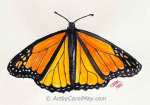- Home
- All about Oil Painting
Unleash the Artist in You: A Comprehensive Guide on How to Oil Paint
Welcome, you're at the perfect place to delve into the wondrous world of how to oil paint.
This guide is here to navigate you through the maze of brushes, colors, techniques, and much more. You'll be armed with the knowledge you need to start your first oil painting.
Fasten your seat belt, unleash the artist within you and dive into the world of painting oils.
 Express yourself with an oil painting!
Express yourself with an oil painting!You want to learn how to oil paint, but you have questions
Questions are wonderful, that's the way we learn. Here are five frequently asked questions:
- What are the basics of how to oil paint?
- What are the best oil paints?
- What oil paint colors do we use?
- What oil paint supplies do we need?
- How to clean oil brushes and more?
Amazon affiliates earn from sales with no cost to you. Learn More
the basics of how to oil paint
There are two basic guidelines for oil painting. Oils are painted thin to thick. Some people say, "Paint fat over lean." It's the same thing.
If we do it the other way around by painting thin over thick paint, the painting may crack after a period of time.
Start a painting thin (lean) by mixing the paint with some painting medium, turpentine or mineral spirits. The thin layer of paint will dry quickly.
how to oil paint
- Start your oil painting with thin layers of paint. Paint thin dark colors first.
- As the paint progresses use less thinner.
- The final layer will be straight paint. Paint the thick light colors last.
As the painting progresses, use less medium and start using thicker, fatter paint. The fat paint dries slower.
The final, fat layer of paint will be straight out of the tube with no medium added. This gives the final layer plenty of time to dry without cracking.
Paint oils from dark to light.
Thinly paint the dark colors first. The final colors are the lightest and thickest colors.
White,
light colors are hard to paint over with dark colors. White on the
other-hand, is opaque and it easily covers darker colors.
More about how to paint a painting
what is a painting medium?
Many oil paints come out of the tube ready to use. So, you may not need a painting medium.
Other oil paints come out of the tube thick and stiff. Thick paint is difficult to brush. Mixing the paint with a painting medium makes it easier to use.
There are a multitude of different painting mediums we could purchase.
We can make our own painting medium by mixing half linseed oil with half solvent (turpentine or mineral spirits).
Store the medium in a glass container with a screw tight lid.
We have a second way to thin oil paint.
Oil paint is manufactured with linseed oil. So instead of using a medium, mix in a little extra linseed oil to make the paint easier to use.
how do we start an oil painting?
Start an oil painting by putting a line drawing on the canvas, panel or canvas board. Use paint that has been thinned with a solvent or medium.
Alternately, do a light pencil drawing directly on the canvas. Or do a drawing on paper and transfer it to the canvas with graphite paper.
More tips on how to start a painting.
What are the best oil paints?
When we are learning how to oil paint, it's best to choose professional, artist paint. There are many good brands of oil paints.
You may be wondering why use artist quality paint because student paint costs less?
Student paints are less expensive because they contain less color pigment.
Less pigment means the paint
doesn't cover as well. So, we may have to use several coats of student paint to get bright, juicy colors.
Artist
quality paints contain more color pigment. So, it takes less paint per painting. They
actually are a better buy after the initial investment.
High quality artists paints produce good quality paintings.
how long does it take oil paintings to dry?
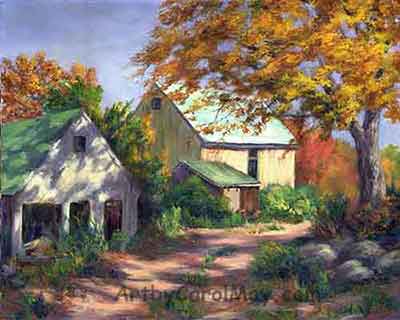 Alkyd painting on canvas
Alkyd painting on canvasOil paintings may take a few days, up to a week or two (depending on the weather) to dry for safe handling.
The various colors dry at different rates. For example, Burnt Umber, Raw and Burnt Sienna dry faster. The cadmium and quinacridone colors dry slower.
Some colors dry with sheen and other are flat without any shine.
Depending on the color and how thick the paint is, it may take up to several months
for an oil painting to dry completely.
Alkyd paint dries within 24 hours
Alkyd paint is made with the same pigments as oil paint. Their
pigment is carried by an alkyd resin instead of linseed oil. They dry very fast compared to oil paints.
They handle and look exactly like oil paints. Their faster drying time makes it easier when we are learning to oil paint.
Griffin alkyd paint made by Winsor and Newton has been my 'oil paint' since the 1980s. They come out of the tube ready to use without adding any medium.
What oil paint supplies do we need?
What do we paint on and what brushes do we use for oil painting?
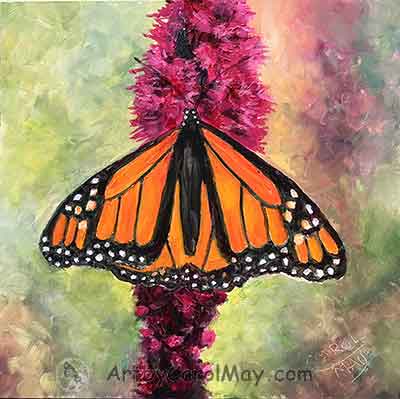 Gessobord is great for details.
Gessobord is great for details.When we are learning how to oil paint, we have a choice of three painting supports.
Canvas is the traditional oil painting support. The 'ad' canvas is stretched over and around wood bars.
Cotton canvas is best for everyday oil painting. Linen with its smooth texture is great for portraits, but it's more expensive.
Panels may be made from wood or synthetic woods such as Masonite. They need to be primed with gesso in preparation for painting.
An excellent archival panel is 'ad' Gessobord. It is primed and ready for painting. It has a smooth surface that is excellent for portraits or other detailed paintings.
A third option is canvas boards. 'ad' Canvas boards are suitable for student work and practice while we are learning.
Ready-made stretched canvas and canvas panels from the art stores are primed with gesso. The gesso keeps the paint from sinking into the canvas.
They are ready to paint on, we don't have to anything extra.
What oil paint colors do we use?
When we are learning to paint oils, begin with the three primary colors, plus white.
- Cadmium Yellow Light
- Cadmium Red Light
- Ultramarine Blue
- Titanium White is the best white for all around painting.
We use more white than any of the colors, so be sure and get a 'ad' large tube of white.
Winton oil colors are considered the best student paints. 'ad' A starter set of 6 oil colors
what brushes are used for oil painting?
Oil painting brushes are generally either soft or stiff.
Soft brushes are made from real animal hair or soft synthetic hairs. They are used for smoother types of work, such as portraits and some still life paintings.
Stiff brushes for oil painting are generally made from hog hair bristles. They are good for expressive work where we may want the brush strokes to show in the finished artwork.
Hog hair brushes are my favorites for ocean paintings.
what brushes should we start with?
Hog hair brushes are great when we are learning to use oils. Stiff brushes move the paint around better and are easier to use with oil paint.
Flats or filbert brushes are both ideal for oil painting. Brights have shorter bristles, so they will leave more brush strokes for bolder creations.
Start with a couple of brushes like #8 and #12.
When learning how to use oil paint, get the feel of using the paints before investing in more brushes.
Using a palette knife to mix colors saves paint compared to mixing with a brush.
Learn more about mixing colors
How to clean oil brushes?
Oil paints contain oil and we will need a solvent to dissolve the oil and clean our brushes.
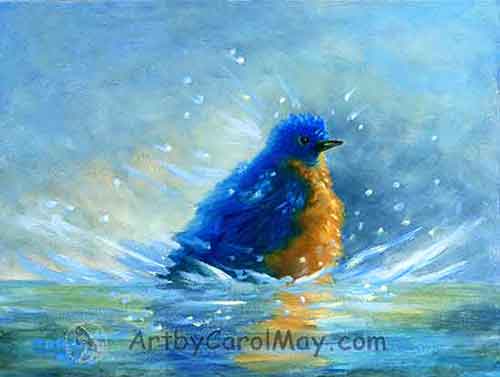 There are lots of fun things to paint!
There are lots of fun things to paint!Modern day artists use odorless mineral spirits or odorless turpentine.
The odorless mineral spirits, 'ad' Gamsol made by Gamblin is considered one the best solvents for studio painting. Keep it in a covered container between painting sessions.
An apron or dedicated paint clothes are a good option for painting art.
Baby oil is noted for taking fresh paint off of clothes. Kiss-Off Stain Remover is supposed to work, but I have never tried it.
If we clean our brushes well with mineral spirits, they may
not need additional cleaning. We may periodically
clean the brushes with 'ad' Masters Brush Cleaner which also conditions the brushes.
Have paper towels available for clean-up while painting.
Where should we paint?
A dedicated painting area will encourage us to paint more often. We can leave our supplies out, so they are ready for painting at any time.
Good lighting is a necessity for painting.
A north window is considered the ultimate light for artists. Otherwise use daylight bulbs which contain full-spectrum lighting.
Regular incandescent bulbs provide a warm light. Paintings done under regular bulbs will appear cool and dull in daylight.
Florescent lights have a blue light that skews our color perception. However, daylight florescent bulbs are available at many building supply stores.
We need good ventilation in our painting area. An exhaust fan or a window cracked open are a good option.
A drop cloth will protect the carpet or floor.
More about our home art studio
what should we paint?
 Start painting small.
Start painting small.Choose a simple subject when we are learning how to oil paint.
Small paintings are fun!
Paint the things we see around us in our environment.
Or paint from some of our own photos.
Be wary of using commercial photos or paintings that have copyrights.
A good place to find photos without copyright restrictions is at Pixabay.
You now have a firm foundation on how to oil paint. We've gone from the selection of artist paints and brushes to the technical aspect of painting mediums, cleaning brushes and lighting sources.
Celebration is in order because you are now equipped with all the necessary knowledge to start your first oil painting project!
Continue exploring the world of painting art with the vast collection of painting resources on ArtbyCarolMay.com. Art is an awesome journey of discovery.
have fun oil painting!
Recent Articles
-
Learning to Paint
Mar 29, 24 12:00 PM
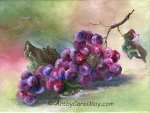 Learning to paint is fun! Millions of people are painting and you can too!
Use these five easy things to jump start your painting journey.
Learning to paint is fun! Millions of people are painting and you can too!
Use these five easy things to jump start your painting journey. -
Easy Butterfly Painting: Watercolor Monarch Step-by-Step Tutorial
Mar 25, 24 03:39 PM
Get creative with an easy butterfly painting tutorial. Discover the joy of drawing and painting a vibrant Monarch Butterfly with simple watercolor techniques. -
Overcoming an Artist's Block
Mar 15, 24 12:00 PM
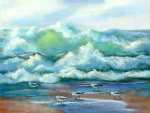 How to survive an artist's block. All artists can have blocks or delays, but we get over it.
What is an art block? How do we get started painting again?
How to survive an artist's block. All artists can have blocks or delays, but we get over it.
What is an art block? How do we get started painting again? -
Bird Paintings
Mar 03, 24 09:11 AM
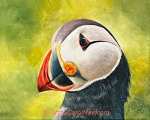 A captivating tribute to our feathered friends.
A captivating tribute to our feathered friends.
The amazing diversity and beauty of birds comes alive with watercolor and oil paintings of birds.
Get inspired to paint the birds you see or simply enjoy…
Recent Articles
-
Learning to Paint
 Learning to paint is fun! Millions of people are painting and you can too!
Use these five easy things to jump start your painting journey.
Learning to paint is fun! Millions of people are painting and you can too!
Use these five easy things to jump start your painting journey. -
Easy Butterfly Painting: Watercolor Monarch Step-by-Step Tutorial
Get creative with an easy butterfly painting tutorial. Discover the joy of drawing and painting a vibrant Monarch Butterfly with simple watercolor techniques. -
Overcoming an Artist's Block
 How to survive an artist's block. All artists can have blocks or delays, but we get over it.
What is an art block? How do we get started painting again?
How to survive an artist's block. All artists can have blocks or delays, but we get over it.
What is an art block? How do we get started painting again? -
Bird Paintings
 A captivating tribute to our feathered friends.
A captivating tribute to our feathered friends.
The amazing diversity and beauty of birds comes alive with watercolor and oil paintings of birds.
Get inspired to paint the birds you see or simply enjoy…




